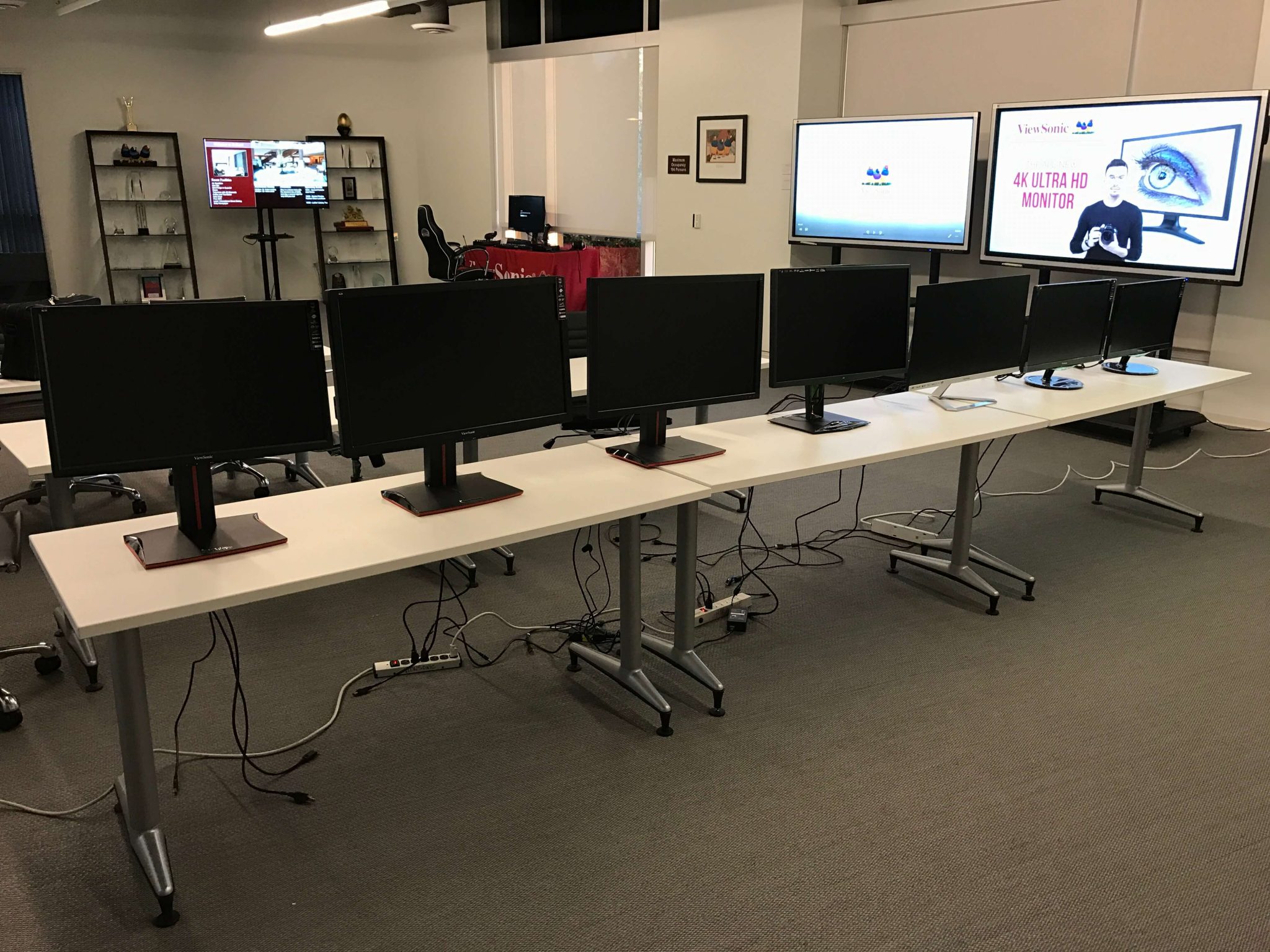ViewSonic as a company has been around for a long time, though their visibility has increased over recent years due to their foray into the gaming world. We previously did a full review on one of their entry-level gaming monitors, the VX2457, which performed admirably in our input lag tests, serving as a decent low-lag option for serious gaming. A little over a week ago, I had the pleasure of visiting ViewSonic’s headquarters located in Walnut, California to take a look at several more monitors within their gaming lineup. All of the models pictured below have a focus on gaming, aiming to provide the lowest latency possible. The models sampled ranged from various size ranges between 22-27 inches, along with a variety of resolutions and panel types.

Several of these monitors feature refresh rates higher than 60hz along with FreeSync or G-SYNC capabilities, so it is possible to reduce the input lag further than our measurements, as they were conducted at 1080p resolution and 60hz refresh rate. The top, middle, and bottom portions of the screen were measured independently, and then averaged to the nearest millisecond. This follows the testing standard established within our input lag database. As a reminder, our rating scale follows this formula:
- Excellent: 0-20ms
- Great: 21-41ms
- Okay: 42-62ms
- Bad: 63ms+
Anything within our “excellent” category will suit the needs of hardcore gamers, and is advised for the most responsive gaming experience.
ViewSonic XG2401 & XG2701:
The XG2401 is a 24-inch 144hz gaming monitor that features 1080p resolution, as well as an advertised 1ms GTG response time. The monitor also comes equipped with FreeSync functionality for supported AMD Radeon graphic cards, providing a tear/stutter free image in most PC games when enabled. The monitor features full height and swivel adjustments, which is an important trait for TN panels due to their limited viewing angles. HDMI and DisplayPort inputs can be found on this monitor, and is a good starting point for those that would like a fast gaming monitor at an affordable price. We measured an average input lag of 10ms, which is an excellent result for low latency gaming. Click here to check the lowest price from Amazon.
Additionally, the XG2701 is the bigger brother of the XG2401, providing many of the same features at a larger size. It still features a TN display and the same 1080p resolution, along with a 1ms GTG response time. The input lag on the 27-inch model however is slightly higher, clocking in an average input lag of 11ms. The 1ms difference should not be detectable during actual gameplay, so feel free to choose the size that benefits your usage the most. Click here to check the lowest price from Amazon.
ViewSonic XG2700-4K:
The XG2700-4K steps up the ante a bit, providing true 3840 x 2160 4K Ultra HD resolution and an IPS display. For those unaware, IPS displays exhibit far better viewing angles and color fidelity over their TN counterparts, at the expense of a little extra motion blur during fast scenes when compared to TN panels. The refresh rate is capped to 60hz and features a 5ms GTG response time, along with FreeSync support for AMD Radeon graphic cards. Similar to the XG01 series above, full height, tilt, and swivel movement is supported, and features HDMI 2.0 and DisplayPort connections. Our input lag test showcased an average input lag of 10ms, putting this monitor as one of our top picks for a 4K IPS gaming screen. You shouldn’t feel any significant latency in serious gaming applications. Click here to check the lowest price from Amazon.
ViewSonic XG2703-GS:
The XG2703-GS is ViewSonic’s premier G-SYNC display aimed at hardcore gamers sporting NVIDIA GPUs. This monitor features 2560 x 1440p resolution, along with an overclocked 165hz refresh rate fitted into an IPS display. While not as crisp as a 4K display, the resolution trade-off comes with the huge benefit of extremely high refresh rates, allowing you to cut down input lag far beyond what’s possible on a 60hz display (assuming your GPU is capable of running the game at a high refresh rate!).
The red styling featured on XG monitors above is replaced with slick green accents to accommodate your NVIDIA allegiance. The panel features a 4ms GTG response time, which is currently the fastest you can expect from its IPS display until technology improves further. HDMI 1.4 and DisplayPort 1.2a connectivity allows you to connect any modern source to this monitor. Surprisingly, our input lag tester measured slighty higher latency numbers than expected, with an average input lag of 12ms. Though, keep in mind these numbers were recorded at 60hz, and running at higher refresh rates along with G-SYNC will likely make input lag a non-issue. The combination of a 1440p display and a 165hz refresh rate strikes the perfect middle ground for hardcore gaming, until GPUs become powerful enough to support 4K resolution with these refresh rates. Click here to check the lowest price from Amazon.
ViewSonic VX2776:
The VX2776 is an entry-level IPS display that is aimed at those looking for a good quality picture, without settling for a TN panel. This monitor features a 1080p resolution and a 60hz refresh rate that is perfect for console gamers. The response time is a bit on the slower end of things though, only providing a 7ms GTG response time, so you may notice some motion blur during fast scenes. However, the input lag values are quite respectable, clocking in at an average 10ms of input lag. This is a very good result for an IPS display, and should provide a responsive gaming experience. I do like the “frameless” design of the monitor, that cuts down on the thick bezels supplied on most modern monitors. HDMI, DisplayPort, and VGA inputs can be found on this monitor, which should be enough for most. Click here to check the lowest price from Amazon.
ViewSonic VX2257:
The VX2257 is the little brother of the VX2457 we reviewed earlier this year, and sports the same entry-level specs as well, including 1080p resolution, 75hz refresh rate, and a 2ms GTG TN panel. FreeSync support is also included, which gives it great value for AMD Radeon users. This monitor is solely designed to cater to those on a tight budget under $200, and can be found quite easily for under $150, making it a solid choice for budget gamers. The monitor provides HDMI, DisplayPort, and VGA inputs to connect most available sources. Our input lag test resulted in an average input lag measurement of 10ms, putting it in line with the VX2457 we reviewed before. Click here to check the lowest price from Amazon.
ViewSonic VP2468:
Finally, ViewSonic’s VP2468 is a hidden gem of this lineup. This monitor isn’t specifically advertised as a gaming monitor, but it’s more than capable of handling the task. The monitor features an IPS display that is pre-calibrated with a Delta E<2 value, and includes a detailed calibration report for sRGB, EBU, SMPTE-C, Rec. 709, and DICOM-SIM color spaces. It features a 5ms GTG response time which is quite respectable for an IPS display, as well as a multitude of inputs including HDMI, DisplayPort, mini-DisplayPort, and USB inputs. The only real drawback of this monitor is its 1080p resolution, but an acceptable one due to the price. The best part? It has an extremely low average input lag of 9ms, making it a great choice for 60hz gaming. Click here to check the lowest price from Amazon.
This concludes our coverage of ViewSonic’s latest gaming screens! All of the displays tested in this article fall under our “excellent” category, and will do great for serious gaming. Please feel free to leave any comments or questions below.







